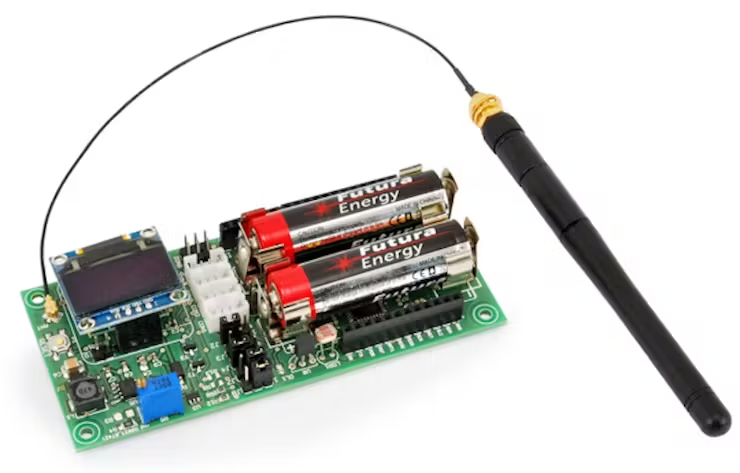Antennino is an Arduino-compatible development board whose name blends “Antenna” and “Arduino.” It features a built‑in 433 MHz radio transceiver, low‑power design, and support for OTA firmware updates over the air.
- Processor: ATMega328P with PicoPower technology (same as Arduino Uno)
- Radio Module: RFM69 operating at 433 MHz, with hardware AES encryption
- Memory: Onboard AT25F512B 512‑Kbit Flash memory for data logging and OTA updates
- Sensors: Built‑in DS18B20 temperature sensor and ambient light sensor; Grove connectors for RS232, I²C, analog, digital I/O
- Optional OLED Display: I²C‑connected, useful in gateway mode
Antennino employs low-power sleep modes via Pied‑Power ATMega328P, awakened either by scheduled wake-up using the watchdog timer or an external event via the TI TPL5110 ultra‑low‑power timer (≈35 nA standby) . A typical battery configuration achieves multi‑year autonomy (e.g. up to 3.5 years on 2400 mAh AA cells).
Using the RFM69 transceiver at 433 MHz provides wide compatibility with unlicensed ISM band use, especially in Europe. AES encryption ensures secure message transmission with minimized interference .
Remote OTA updates are supported: Antennino can act as a gateway to manage firmware versions stored in Flash memory and deliver updates wirelessly to remote nodes, enabling updates without physical access .
Common use cases include:
- Battery‑powered sensor nodes (temperature, light, door alarms, vibration alerts)
- Gateways running on Antennino or host platforms like Arduino Uno or Raspberry Pi with RFM69 modules for data collection and processing
- Two AA batteries (alkaline or NiMH)
- External power between 3.6 V and 12 V
- Direct 3.3 V input (bypassing regulators)—must not exceed 3.3 V
At 433 MHz, the wavelength λ is approximately 0.6928 m. Effective antenna length is often a fraction. Antennino supports an external antenna via a U.FL connector for better range and efficiency .
It is fully programmable via the standard Arduino IDE. Grove connectors allow flexible integration with external modules, making it easy to attach sensors, actuators, and expand functionality .
- Significantly lower power usage
- No reliance on WiFi infrastructure
- Ideal for small data payloads in long-range IoT deployments
- Avoids WiFi congestion and bandwidth issues
- Limited data throughput (~few kilobits/sec)
- Operates solely on 433 MHz—may require regulatory compliance depending on region
- Range and interference depend on antenna tuning and environment
Antennino is available directly from Open Electronics or affiliated retailers, retailing at around 30 € (~$35 USD). Starter kits and accessory antenna items (e.g. 5‑piece spring antennas) are also sold .
Boards like LoRa‑based or WiFi‑based Arduino clones offer higher speed or longer range—but Antennino delivers a unique tradeoff: ultra-low idle current, moderate range, native OTA support, and AES‑secured communication.
- Leverage TPL5110 for timed wake-ups
- Use ReadTrigger() logic to distinguish scheduled vs external wake events
- Choose external antenna and position wisely to maximize range
- Monitor battery voltage periodically to avoid unexpected shutdowns
- Custom sensor networks for agriculture, industrial monitoring, or door security
- Raspberry Pi acting as central gateway with database logging and remote management
- Integration into smart‑home automation or remote environmental sensing systems
Q1: What is the main feature of Antennino?
A1: Antennino combines Arduino‑compatible development with a built‑in 433 MHz RFM69 radio, ultra‑low power operation, and wireless OTA firmware updates.
Q2: How long can Antennino run on battery?
A2: With proper low‑power configuration and use of a TPL5110 timer, it can run on 2 AA batteries for several years (e.g., ~3.5 years with 2400 mAh cells) .
Q3: Can I update the firmware remotely?
A3: Yes, OTA updates are supported using onboard Flash memory acting as a gateway to distribute firmware to remote nodes.
Q4: Is antenna included?
A4: A spring antenna may be included as an accessory—Antennino also features a U.FL connector so you can attach a larger external antenna for better range.
Q5: What security does it offer?
A5: The RFM69 radio supports AES encryption in hardware, helping secure wireless communication.
Q6: Can I integrate other sensors or actuators?
A6: Yes—Antennino includes Grove connectors for I²C, RS232, analog and digital I/O, allowing easy expansion with external modules.
Q7: How does Antennino compare to LoRa boards?
A7: LoRa modules offer longer range (kilometers) but are often more complex and higher power; Antennino targets battery‑efficient local IoT deployments with simpler setup.
Antennino offers a compelling platform for IoT projects requiring low power, secure wireless communication, and remote management. With its Arduino IDE compatibility, manageable cost (~30 €), and flexible deployment as sensor nodes or gateways, it stands out as a practical solution for remote sensing, home automation, security, and beyond.

